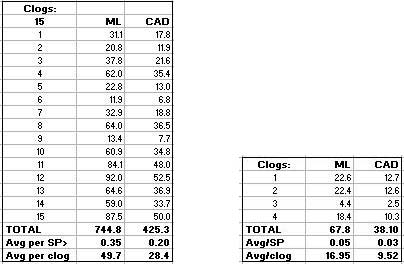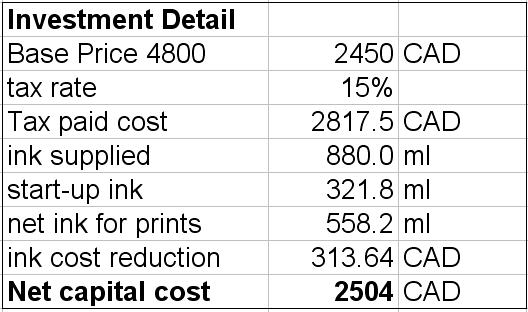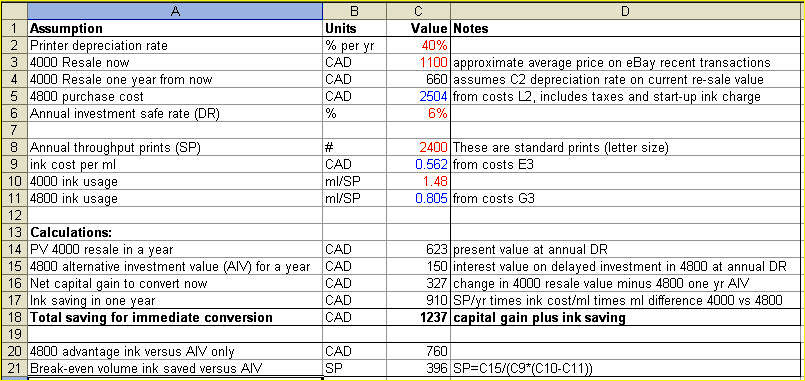By: Mark Segal
Note to readers:Calculations in this article are done in Canadian dollars.
At the time of publication the exchange rate to the U.S. dollar is approximately 1.15X.
In other words, a Canadian dollar is worth about 87 cents U.S.
Readers of myprevious essaywill be familiar with the model I developed to track the costs of printing with an Epson 4000. On November 1, 2005 I took delivery of the new Epson 4800 and restarted the same model for tracking the cost of using it. Almost four months later and with about 1,300 “Standard Prints” (SP)– 54 square inches of image on Epson Enhanced Matte paper– under its belt, I am pleased to report that the 4800 is economically so much superior to the 4000 that anyone sitting on the fence wondering whether they should up-grade will find the information in this up-date of significant interest. For this essay, I developed a special add-on to the model which calculates the economic advantage of up-grading from the 4000 to the 4800 sooner rather than later, and it shows the threshold number of SP per year needed to justify the up-grade, looking at the cost factor alone.
A word of caution: the calculations here DO NOT include the cost of changing ink when switching from matte to non-matte media. This is for three reasons. Firstly, I have no personal experience doing so. Secondly, the cost depends on how often one changes inks, relative to the number of prints made, and there is no way to standardize this –– it will vary immensely from user to user. Thirdly, this exclusion maintains the comparison between the 4800 and the 4000 on a level playing field. The 4000 didn’t require changing inks, but its non-matte output was not the quality of 4800 non-matte output. A valid comparison must compare comparable things.
An important contributor to the cost of ink for the Epson 4000 was ink consumed for cleaning nozzle clogs. My first observation of the performance difference between the 4000 and the 4800 is how much better the 4800 performs in respect of clogs. By September 30, 2005 when I finished using my Epson 4000 for about 2200 SP it had accumulated 15 episodes of major nozzle cleaning. Table 1 below shows this cost me about 749 ML of ink for 425 Canadian dollars (CAD), averaging $28.40 per clog and 20 cents per SP. With my 4800, for about 1,300 SP, it has accumulated 4 minor clogs, costing about 68 ML of ink for $38, averaging $9.50 per clog and 3 cents per SP. Table 2 shows that so far on a per print basis the 4800 is performing about seven times better than did the 4000 with respect to nozzle clogs. Not only is there far less clogging per print, but each clog requires far less ink to eliminate it.
Tables 1 and 2

My second observation is that the 4800 requires far less ink to produce a print, absent any cleaning, than did the 4000. To date, my 4800 is using 0.65 ML per SP, whereas the 4000 was using 1.05 ML, or 61% more ink than the 4800 [(1.05-0.65)/0.65]. This is a huge difference, indicating that Epson has achieved a very substantial printing economy improvement with the release of the 4800.
The overall differences in cost of ink for the two printers (including prints and all cleanings), are revealed between Tables 3 and 4 below, indicating that ink cost for the Epson 4800 is just a little over one half that of the 4000 (45 cents per SP versus 84 cents).
Table 3

Table 4

This immediately raises the question about whether it pays for owners of the 4000 to upgrade to the 4800. The answer to this question depends on how one views the investment cost relative to the ink saving.
Let us first develop the investment cost for a 4800. It is the purchase price plus applicable taxes (15% in Ontario), less the tax-paid value of the 880 ML of ink supplied with the purchase, plus the tax-paid cost of the one-time deadweight loss of 322 ML ink (out of the 880 ML) the machine consumes at first start-up (effectively removing from capital cost net 558 ML of ink to be expended on printing as part of printing cost). These calculations are developed in Table 5, indicating an investment cost of about $2,500 CAD all-told.
Table 5

There are two considerations relating to this investment cost for present purposes: (1) the resale value of one’s Epson 4000, and (2) the annual value of, say, saving the approximate $2,500 CAD it would cost to invest in an Epson 4800. The annual value of this saving should be accounted at the amount one would earn investing the $2,500 for a year at a “safe rate of interest” (after tax). I estimate this rate at 6% per year, but it varies.
The resale value of an Epson 4000 has been dropping quite rapidly. Based on eBay completed sales, in November 2005 it was about CAD $1500. Now, mid-February 2006), it is down to about CAD $1,100. This reflects what we already know –– digital photographic equipment depreciates rapidly once newer models hit the market. I am going to assume for illustrative purposes here that the 4000 will have depreciated 40% from its current value come a year from now. So selling an Epson 4000 now earns about CAD $1,100, whereas a year from now it may fetch CAD $660, which discounted to present value at the same 6% interest rate is worth about CAD $623 now.
The annual value of saving the $2,500 at 6% (instead of splurging on the 4800) is CAD $150 (2500 * 0.06).
Let us also assume, for sake of an example, that one would make 2400 SPs in a year.
We now have the elements we need to determine whether it pays to up-grade. These calculations are provided in Table 6.
Table 6 The Up-Grade Advantage

If this label is too hard read in your web browser, right click on it and then download it.
It may be more easily read in an image editing program.
The basic information we discussed above is in rows 2 to 11. The results are in rows 14 to 18. Rows 16 and 17 deserve a bit of explanation not yet provided. Row 16 says that 1100 minus 623 is gained selling the 4000 now rather than waiting another year, but the advantage of this is reduced by the 150 interest lost spending the 2500 now instead of investing it. Hence the net capital gain for selling it now is 1100-623-150, or CAD $327 as shown in cell C16.
More important is row 17, which says that CAD $910 is saved in ink for the 2400 prints. This is calculated as the difference in ML/SP between the two machines times the price per ML times the number of prints, or 2400*(0.562*(1.48-0.805). (Note: some data in Table 6 is shown up to two decimal places, but the table calculates beyond that.)
The “bottom line” is row 18, which adds the savings from the two sources (net avoided depreciation loss and ink saving), resulting in a total net saving of CAD $1,237 for immediate up-grading. That is half the price of the 4800 recaptured in one year!
Some people may say, forget about the avoided depreciation loss –– too speculative – you don’t know what the machine will be worth in a year, so don’t count it. Fine. But the immediate sale still nets the difference between the ink saving and the foregone interest from spending the $2,500, shown in cell C20 as CAD 760.
Well, you may say, that’s fine and dandy, but what happens if I don’t make 2400 prints in a year. How few prints per year can I make before the up-grade becomes indifferent, again ignoring the depreciation loss of delaying the up-grade? Table 6 answers that question too, in cell C21. By dividing the value of the ink saving per SP into the interest earned for a year of investment delay, the result is that one only needs to make 396 prints per year to justify this up-grade. That’s only 33 prints per month or a little over one a day. My betting is that just about anyone who prints that little isn’t reading this essay. So as long as other 4800s behave like mine is, the result emerging from all this record-keeping and calculation is a no-brainer: Up-grade ASAP.
Mark D. Segal
Toronto, February 2006
You May Also Enjoy...
Roundshot
By Bill Glickman Seitza small Swiss camera manufacturer is the industry leader in rotational cameras. They offer 35mm, MF and 70mm rotational cameras. The
Lunar New Year
By Michael Reichmann I woke up this morning in a good mood . I really did. Then my mood crashed when I saw a Hasselblad
